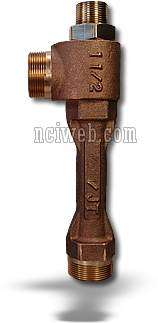Jet Pumps
Using Liquid as the operating medium
Jet Pumps are stocked in Carbon Steel, 316SS and Bronze from sizes 1/2″ through 3″

Water jet eductors also known as jet pumps, utilize the kinetic energy of one liquid to cause the flow of another. Jet pumps for pumping operate on the basic principles of flow dynamics. This involves taking a high pressure motive stream and accelerating it through a tapered nozzle to increase the velocity of the fluid (gas or liquid) that is put through the nozzle. This fluid is then carried on through a secondary chamber where the friction between the molecules of it and a secondary fluid (generally referred to as the suction fluid) causes this fluid to be pumped. These fluids are intimately mixed together and discharged from the eductor.
Northeast Controls (uniquely) has more than 50 years of experience with jet pumps and in tank mixing applications. Our tank mixing experience covers both tank mixing eductors and propeller type side entry mixers involving tanks in sizes up to one million barrel (42 million gallons) capacity.
Pressure Ratings
While the competition design their eductors for nominal pressure ratings, JT Eductors are designed and produced to meet rigorous ASME/ANSI specifications. We offer eductors and jet pumps with ratings about 30% higher than most competitor’s products.
Ratings: 316SS: 720 psig @ 100 F | Carbon Steel: 740 psig @ 100 F | Bronze: 500 psig @ 100 F
Wrench-Flat Design
All jet pumps from 1/2˝ to 3˝ have a standard wrench flat to allow ease of assembly. This eliminates the need for a pipe wrench and minimizes damage to the body.
There are three connections common to all jet pumps (venturi eductors).
MOTIVE Connection: This connection is where the power for the eductor is generated, by increasing the velocity of the motive fluid. The eductor nozzle in this section takes advantage of the physical properties of the motive fluid. Eductors with liquid motives use a converging nozzle as liquids are not generally compressible. Eductors with gas motives utilize converging-diverging nozzles to achieve maximum benefit from the compressibility of the gas. All nozzles for eductors have smooth flow paths. Flow paths with sudden steps or roughness on these high velocity surfaces cause jet pumps to operate less efficiently.
SUCTION Connection: This connection of the eductor is where the pumping action of the eductor takes place. The motive fluid passes through the suction chamber, entraining the suction fluid as it passes. The friction between the fluids causes the chamber to be evacuated. This allows pressure in the suction vessel to push additional fluid into the suction connection of the jet pump. The high velocity of the motive stream in this section of the eductor directs the combined fluids toward the outlet section of the eductor.
Discharge Connection: As the motive fluid entrains the suction fluid, part of the kinetic energy of the motive fluid is imparted to the suction fluid. This allows the resulting mixture to discharge at an intermediate pressure. The percentage of the motive pressure that can be recovered is dependent upon the ratio of motive flow to suction flow and the amount of suction pressure pulled on the suction port. The mixture then passes through the diverging taper that converts the kinetic energy back to pressure. The combined fluid then leaves the outlet.
Total customer satisfaction comes from the combination of quality products purchased at a reasonable price and delivery quickly and when promised.
Jet Pumps are in stock from 1/2″ up to 3″ sizes. Jet Pumps are stocked in Carbon Steel, 316SS and Bronze. Tanks Eductors are stocked in sizes from 3/8″ up to 3″ in both Carbon Steel and 316SS. We stock PPL & PVDF materials in sizes from 1/4″ thru 1-1/2″.
General Performance Table
| Discharge Head Level & Model | Low = SL | Medium = ML | High = HL |
| Operating Medium | Liquid | Liquid | Liquid |
| Operating Medium Pressure Range | 15-200 PSIG | 15-200 PSIG | 15-200 PSIG |
| Nom Oper Med Press PSIG/ft of Discharge Head | 2.0 PSIG (SP.GR. 1.0) | 1.5 PSIG (SP.GR. 1.0) | 1.0 PSIG (SP.GR. 1.0) |
| Discharge Head Pressure Range | to 50 FT. | 40 to 80 FT. | 80 FT. or more |
| Suction Lift | to 27 FT. | to 27 FT. | to 27 FT. |
| Minimum NPSH | 3 FT. | 3 FT. | 3 FT. |
Tefzel™ Lined Eductors
In erosive/corrosive applications, Tefzel™ Lined Eductors offer a durable lined interior surface that performs flawlessly, even when subjected to internal temperatures of up to 300°F. Tefzel™ lining can extend jet pump service life in cases where abrasive solids and slurries accelerate wear.
- Northeast Controls Incorporated
- Lewes, Delaware 19958 USA
- Tel: 1+201.419.6111 ext. 23 for venturi group
- sales@nciweb.com
